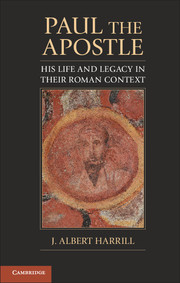Book contents
- Frontmatter
- Contents
- Figures and Boxes
- Preface
- Introduction
- PART I The Life
- 1 From Pharisee to Apostle
- 2 Communities in the Making
- 3 Paul's Life in Its Roman Context
- PART II The Legend
- Appendix 1: Extant Writings Attributed to Saint Paul in Rough Chronological Order
- Appendix 2: Reconstructing Paul's Corinthian Correspondence: A Puzzle
- Appendix 3: Ancient Christian Works Containing Pauline Traditions and Legends
- Notes and Further Reading
- Bibliography
- Index of Biblical Citations
- Index
2 - Communities in the Making
Published online by Cambridge University Press: 05 November 2012
- Frontmatter
- Contents
- Figures and Boxes
- Preface
- Introduction
- PART I The Life
- 1 From Pharisee to Apostle
- 2 Communities in the Making
- 3 Paul's Life in Its Roman Context
- PART II The Legend
- Appendix 1: Extant Writings Attributed to Saint Paul in Rough Chronological Order
- Appendix 2: Reconstructing Paul's Corinthian Correspondence: A Puzzle
- Appendix 3: Ancient Christian Works Containing Pauline Traditions and Legends
- Notes and Further Reading
- Bibliography
- Index of Biblical Citations
- Index
Summary
Now in his mid or late forties, Paul began a new mission (ca. 50), which involved frequent travels in Asia Minor, Macedonia, and Greece. We do not know Paul's actual missionary routes. In this regard, maps of the “journeys of Saint Paul” mislead about the nature of our sources. To be sure, the book of Acts narrates his three so-called missionary journeys: the first in Cyprus and Asia Minor (Acts 13–14); the second in Asia Minor, Macedonia, and Greece, in which Paul appears before the famous Roman governor Gallio (alias Marcus Annaeus Novatus, the elder brother of the philosopher Seneca and proconsul of Achaea in 52) (Acts 15:40–18:22); the third along a similar route but with a three-year stay at Ephesus, and ending in Jerusalem (Acts 18:23–21:16). Acts narrates also a final (fourth) journey of Paul, from Jerusalem to Rome, as a prisoner for a trial before an unnamed Roman emperor who would have been Nero (Acts 27:1–28:16). But the historical reliability of these legendary grand tours, as we shall see, is doubtful.
Paul's Travels
Paul's own letters do not describe a pattern of three great “tours.” Unlike the accounts in Acts, no trips were “commissioned” by church leaders in Jerusalem, Antioch, or elsewhere. Certainly, Paul was a traveler. We know, for example, that he followed the main Roman East–West road, the Via Egnatia, in southern Macedonia from Philippi down to Thessalonica, and also that he reached Corinth through Athens (1 Thess. 2:2; 3:1). He visited Corinth at least three times (1 Cor. 2:1; 2 Cor. 1:23; 13:1), had an extended stay (and a likely imprisonment) in Ephesus across the Aegean (1 Cor. 15:32; 16:8; cf. 2 Cor. 1:8), and returned at least once to Macedonia via the Asia Minor port of Troas on the Hellespont (2 Cor. 2:12). Paul typically sent associates ahead of him to prepare for his arrival in a city (Phil. 2:19; Philem. 22), sometimes losing track of their whereabouts when his travel plans changed (1 Cor. 16:10–11). Paul, in retrospect, described his missionary travel as a geographical circle (Greek kuklō) around the Aegean, whose gigantic arc stretched “from Jerusalem and as far around as Illyricum” (Rom. 15:19) (see Figure 2). Paul's reference to Illyricum (modern Bosnia and Herzegovina, Serbia and Montenegro, and Albania) is unclear.
- Type
- Chapter
- Information
- Paul the ApostleHis Life and Legacy in their Roman Context, pp. 46 - 75Publisher: Cambridge University PressPrint publication year: 2012



